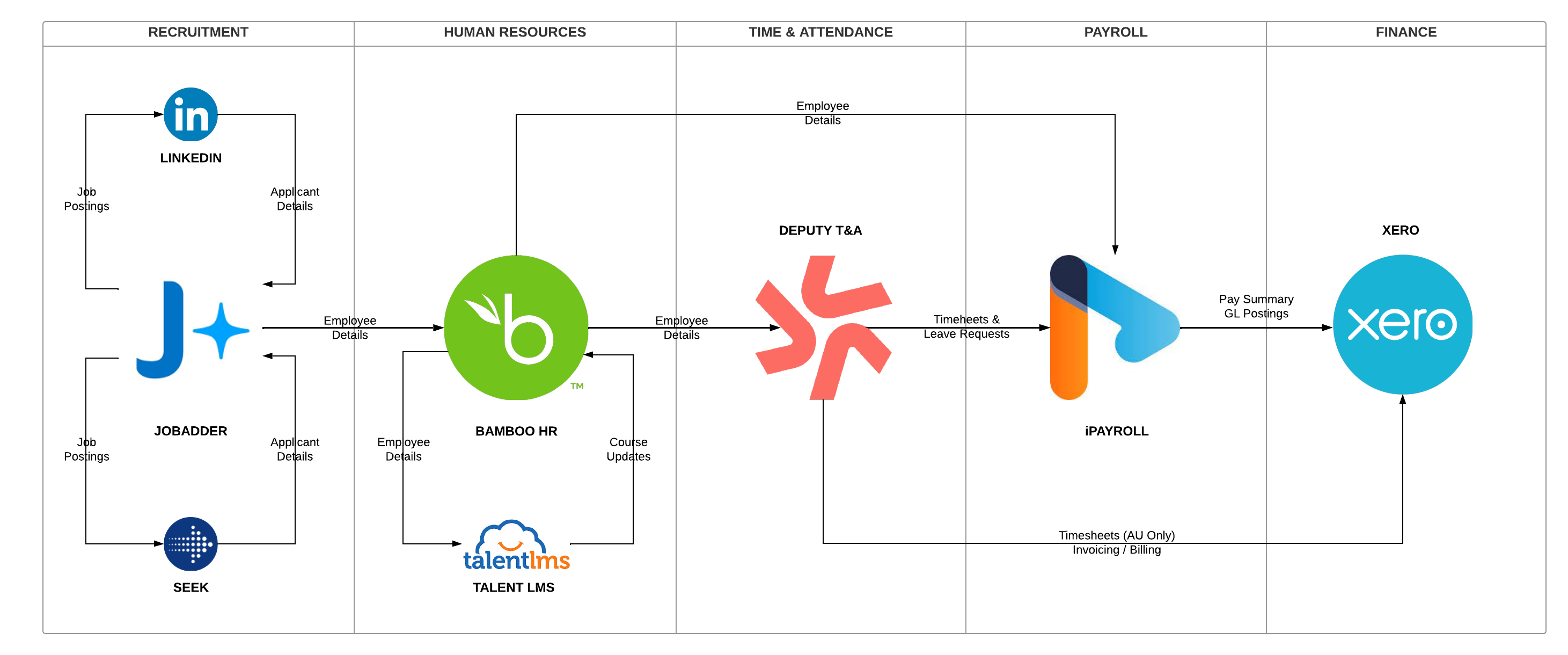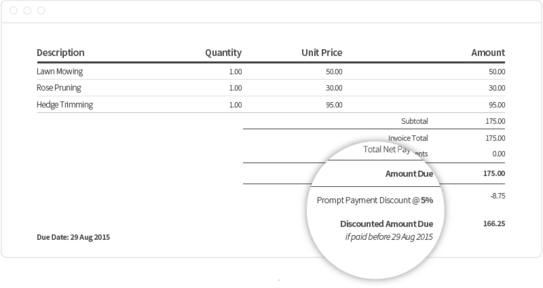Mastering Workflow: A Guide to Choosing the Right Software
When it comes to selecting employee management solutions, it can be easy to feel overwhelmed by the multitude of options available. Here we break down how to choose and some platforms to know about.
How to Choose:
With market factors like increasing compliance requirements and labour shortages, it’s never been more important to choose the right workflow software. We recommend that businesses always start by mapping out the employee lifecycle from end to end. We then suggest reviewing what tools and resources are needed at each step. Two key things to consider are automation and ease-of-use; employees will be able to best utilise a system that’s engaging and straightforward.
Four Platforms to Know About:
As platform-agnostic providers, we can subjectively recommend which services can best suit your business. Below, we've rounded up some of our favorites:
- Deputy
- Offers powerful rostering and timesheet management for larger workforces
- Boasts strong awards management, e.g. overtime, additional entitlements
- User-friendly and engaging for staff
- Adapts to a multitude of industries, including healthcare, hospitality, construction, manufacturing and agriculture
- Bamboo HR
- Comprehensive HR management system
- Ideal for internal HR functions
- Rich in HR-specific features covering areas like recruitment, onboarding and certifications
- Built to seamlessly integrate with payroll, LMS (learning management), and time & attendance
- iPayroll
- Provides an outsourced legal service alongside the HR software
- Ideal for businesses looking to outsource the HR function
- Developed here in New Zealand
- PayHero & Droppah
- Ensures payroll compliance with the Holidays Act
- Integrates rosters and timesheets
- Ideal for SMBs with employees on variable hours
What’s Next?
If you’re interested in increasing your workplace efficiencies through software, drop us a line to connect. We’d love to discuss your options.
The Time is Now: The Power of Digital Transformation
In a world where business applications and automations have advanced further than ever before, a holistic approach to digital transformation is often essential for businesses operating on outdated legacy systems. There are a myriad of reasons why businesses are so positively impacted by making the switch; we look at three of the key ones below:
1. Cloud integration
This is the number one advantage of a digital transformation. The clue is in the name: cloud integration takes multiple platforms - from sales and customer service, to operations and logistics, to finance and accounts - and integrates them. In simple terms, the systems talk to one another.
2. Staff wellbeing
An integrated digital solution gives insight, transparency, and visibility across all departments, which positively impacts staff productivity and well-being. Clients we’ve led through these transformations report reduced staff stress levels, decreased burnout, and lessened pressure on staff. You can imagine how errors are reduced as many time consuming processes become automated, which naturally instills confidence and a more positive work environment.
3. Scalable growth
A digital transformation is proven to enhance data security, maximise supply chain efficiencies, revise energy consumption, support compliance, minimise risk and generate customer insights. Ultimately, it brings the business into the ‘now,’ driving its accessibility and compatibility, and optimising it for success in today’s digital-first landscape.
The most effective digital transformations are led by trusted partners with expertise spanning various disciplines like ERP, CRM and ECOM. Unlike some of the other players in the space, we firmly believe that partners should remain technology-neutral, giving them the ability to analyse the unique needs of each business before offering a tailored solution. At ALTSHIFT, we take this one step further with a team of in-house developers who are able to fine-tune customisation to the point where we can (and do!) create bespoke apps.

We appreciate that many operators feel overwhelmed by the idea of transforming all of the software across their business; with never ending to-do lists, it can be hard to imagine finding the time and energy to get started. That’s where we come in; BDO has powered ALTSHIFT to give businesses the ability to outsource the digital transformation process.
We work with businesses of all sizes and industries, successfully guiding digital transformation journeys for companies like RUBY, Medi Foods and Black Magic Tackle. We lead every step of the process, from initial analysis and solution recommendations, to migration and integration, to staff training and technical support. If you’re interested, email me on josh.ambler@bdois.co.nz and let’s catch up for a coffee to discuss.
Working Smarter With The Cloud
Through the lock-down many businesses have enabled remote working and realised the benefits of investment in technology. No doubt there have also been frustrations with working in a ‘paperless’ environment, accessing legacy technology and modifying historic business processes.
The ALTSHIFT team will discuss practical technology solutions you can utilise in your business to achieve smarter ways of working including;
eCommerce integrated to inventory and finance
eCommerce automation with shipping and tracking
Accounts payable automation
Automated debtor collection
Online reporting tools
Please watch the video below to find out more...
Ten Key Things to Consider When Implementing Digital Transformation
Data collection and analysis are integral to business success and growth, and most businesses have already adopted digital transformation strategies to ensure they thrive in competitive markets now and in the future. Digital transformation affects all aspects of a business, from digital marketing to business operations, so this transition process should be handled carefully. If you’re thinking of moving towards digitization, here are the key things to keep in mind to ensure digital transformation success.
Strategy. An overall digital transformation strategy must be in place to avoid using a shotgun approach or doing bits and pieces at a time. Strategy requires building a set of requirements tailored to your business’ needs and documenting them to create a brief.
Expertise. Consider whether you have the expertise internally to execute the strategy or if you need to engage with external contractors, partners, or experts.
Research. Gather information on products, platforms, and technology that might be considered as part of the transformation, e.g. different accounting platforms, e-commerce platforms, etc. Book vendor demonstrations and workshops if they offer that service.
Peer Review. Check vendor references, online reviews, and meet up with existing users. This way, you’re able to base your decision from a wider pool of experience and information.
Future-proofing. Make sure the solution you intend to adapt is future-proofed. Technology moves fast, so be avoid using software that's likely to become obsolete within the next few years.
Automation. Automation is an integral part of digital transformation. Ensure your solution can automate internal processes, fix any current problems, or remove a current bottleneck with little to no human intervention.
Insight. Consider whether the solution will provide more insight, analytics, transparency, or allow you to look at the business activity in a different way.
Budget. What is the cost/budget and timeline to execute the strategy? Consider 2% of turnover to be a good starting point for a digital transformation budget.
Delivery. Create a project plan with a clear sequence of events and designate a champion for the delivery. They must be responsible for executing the strategy—internally and/or externally.
Change Management. This is the human element of digital transformation. Managing change internally requires managing people's emotions and egos, gaining staff buy-in, and getting people on board with the strategy. Pre-empting human issues or resistance can make a big difference to the success of a project.
Attitude. As an extra yet essential step, it’s important to remain positive, seek out the positive benefits of change, and focus on what new opportunities the solution creates. Understanding the limitations of a system is important, but try not to critique it too much, as you will always find limitations with software. There is no perfect system. What’s important is that, overall, there is improvement, efficiency is gained, and/or it solves more problems than it creates.
ALTSHIFT provides professional support for optimizing business information systems. If you require professional advice regarding your business information systems, reach out to the ALTSHIFT team today. Our trained experts, practitioners, and consultants understand that powerful information systems ranging from inventory systems to workflow are behind every leading business.

Simple yet robust - an automated expense entry and approval process for Xero

With a huge up take of Xero these days many clients are taking the next step to further automate their systems. Although Xero itself has some basic ‘approval’ functions, often this is not enough for a business complex approval workflow.
Examples include:
Branch managers only want to approve bills for their own branch
Managers or CFO’s need to approve bills over a certain limit
Requiring more than one person to approve a bill
Having an approval delegate when a manager is on leave
Sending automated reminders to managers when they bills to approve
Or any combination of the above!
With a tool like ApprovalMax, businesses using Xero can have these complex approval workflows and digitize them for the modern era, keeping a digital audit trail and removing unnecessary paper and printing from the process.
Furthermore tools like Receiptbank remove the data entry from the beginning of the process (receiving the bill and have it auto-entered into the accounting system with appropriate coding).
With the 2 combined processes moved into the cloud, you have digitized the entire accounts payable process from start to end!
Celebrating the launch of BNZ MyBusiness Live
In anticipation of the launch of BNZ’s new MyBusiness Live Dashboard (powered by 9Spokes), ALTSHIFT was invited to Wellington to represent TradeGecko at a networking event designed to connect app partners of the 9Spokes eco-system with senior BNZ partners. With the uptake of cloud software in business, BNZ is at the forefront offering a free BI dashboard to BNZ and non-BNZ customers alike.

The MyBusiness Live Dashboard allows you to easily connect a wide array of cloud systems which enables business leaders to configure an array of widgets to display key performance metrics. This in turn provides valuable insights that would otherwise take months to prepare; at the click of a button. Business leaders who utilise MyBusiness Live will have the data to monitor the vital signs of a business that may otherwise be missing from the P&L, leading them to make smarter business decisions.

Among ALTSHIFT and TradeGecko, we were joined by other apps from the 9Spokes/MyBusiness Live eco-system. We had a wonderful time networking with the folks from apps such as Xero, MYOB, Tradify, Shopify, Exsalerate, Hedgebook, Debtor Daddy and Business Sorter.
Why should my business use a 3PL?
One of the most complex components to effectively scaling up a business is the management of an efficient supply chain. As a product-based business grows, so too does the throughput of product through an ever thinly stretched supply-chain. All of the moving pieces in your supply chain must continue to operate in perfect alignment to avoid bottlenecking in process, and unfortunately in the costs associated with deploying a new fulfilment/dispatch location can be quite high. Thankfully the option of utilising a third party logistics partner (3PL) exists.
3PLs are uniquely positioned in the fulfilment space in that they are equipped with the knowledge and resources for businesses looking to expand their reach (whether within their existing territories, or into new ones). One of the advantages of using a 3PL is the sharing and distribution of costs among partners. Simply put, instead of your business paying for an entire facility, your business is able to use the space in the facility that it requires. This way your business is only paying for what it uses. This aspect is particularly useful if your business has regularly fluctuating inventory levels (selling seasonal stock being the example). Other costs associated with warehousing such as labour are proportionately distributed among the 3PL’s clients. If your business cannot keep a warehouse full of product year round, this makes partnering up with a 3PL a very cost effective option.

Another reason to partner with a 3PL is the ability to leverage their international reach. As opposed to investing in a warehouse in a foreign territory and shouldering the burden of operating a warehouse in a country with different regulations and currency, you could partner with a 3PL that has locations globally and leverage their local know-how in the territory you want to expand in. To increase service levels and reduce costs, it is essential to have your product based close to where your customers are. Engaging with a 3PL is typically done so on a contractual basis, meaning visibility at a transactional level. This holds 3PLs to a much higher degree of accountability with tracking of key performance indicators.
Naturally, switching to a 3PL blazes a path for the automation of the fulfilment and dispatch functions of your business. This extensive automation frees up staff to perform higher value tasks. In order to achieve this, it is key to have the right technology and business processes in place to facilitate this. ALTSHIFT has consulted upon and executed numerous extensive cloud ERP implementations, which have included platform integrations to 3PL partners. The scope of these integrations include automatic fulfilment of e-Commerce orders, fulfilment of wholesale orders and more. Have a question about your systems and scope for 3PL integration? Have a chat with the experts.
What is EDI?
EDI, standing for Electronic Data Interchange, is the electronic transaction of business data between business partners that follows a standardised format. EDI facilitates the ability for one business to send information to another. Many business documents are transacted through EDI, however the two most common are purchase orders and invoices. The expenses incurred with traditional business communication (mail handling, paper, reproduction, filing, storage and retrieval) are effectively eliminated, and EDI has been found to reduce associated administration costs by at least 35%.

Why should my business use EDI?
Another benefit of using EDI over traditional transaction methods is the elimination of data entry errors. This further reduces your cost of doing business, and frees up your staff to perform higher value tasks. The real-time nature of EDI also allows increased visibility which allows for more strategic business decisions. Consequently the reduced order processing and delivery times allow for reduced inventory levels. With less inventory on hand, there is less precious capital tied up in product and more cash-flow.
As a business grows and begins trading with bigger customers, they may quickly find that their trading partners require them to transact with EDI. In order to be compliant with these types of customers, small businesses may be provided with an EDI web portal to make or receive orders. When starting out your business may be able to shoulder this administrative burden, but it does not make for a scalable process. Thankfully with the right technology EDI can be implemented into your business processes, and you too could reap the benefits.
ALTSHIFT is a consultancy firm that implements cloud business solutions, and consequently we have also done a wide array of EDI connections as part of bigger cloud ERP projects. If you are thinking about scaling up your business but not sure whether your systems stack is up to the task, get in touch with one of our experts for a consultation.
Why move your business to the Cloud?
Cloud computing is quickly becoming one of the biggest and most revolutionary technological movements in business. “Cloud” is a catch-all term that encapsulates everything from storing files on a commercial service like iCloud or Dropbox, right down to remotely hosting and maintaining the entire internal infrastructure of a Fortune 500 company. At its most basic definition, cloud computing is the outsourced rental of storage or processing resources, as opposed to hosting/managing your own hardware.
Business systems such as ERP or CRM software that are hosted in the cloud tend to follow the SaaS model (Software as a Service). SaaS based licensing tends to take the form of monthly or annual payments, as opposed to the initial outlay of capital that typically is required for on-premise deployments. There is no server hardware to purchase or updates to operating systems and software, this is managed by the software or hosting vendor and is included in the subscription price. The hosting costs of an on-premise implementation that are often overlooked include backups, disaster recovery, load balancing of processes at peak times and security. The beauty of SaaS systems are the economies of scale, to the end user the delivery is similar but often at a cost saving. As a businesses needs change, the SaaS model offers scalability with the addition of users and modules being a quick and painless affair.

There are two types of cloud deployment to be aware of, single-tenanted and multi-tenanted. A single-tenanted implementation is essentially the same as an on-site implementation except that the hosting is outsourced. This, in essence, is the rental of off-site server hardware where a traditional ERP system would be run. Multi-tenanted SaaS software is one underlying application with businesses each having their own separate and secured database. Multi-tenanted SaaS software benefits from the ability to make updates and changes to the core application, and roll these out to users instantly ensuring users are always up-to-date.

When selecting an ERP system for your business, one thing to be aware of is cloud adaptations of legacy software. What vendors will do is take their legacy incumbent ERP software and port it to be used “in the cloud”. In practice these types of solutions require client side software to access the platform, or even a special server to sit between the software and the user. Using this type of system results in a less than ideal user experience, the speed and responsiveness of this type of software will never compare to that of a true cloud solution. True cloud applications need nothing but a browser on the end-users computer, and can be accessed from anywhere in the world.
Cloud deployments of business systems are an attractive proposition for businesses looking to implement new technology, however with any system decision there are a lot of avenues to be explored. Engaging with an ERP project consulting firm like Alt Shift allows you to leverage our industry experience to find the best possible solution for your business.
Let the tool do the work.
Learning to use a handsaw when I was young my Dad would tell me not to strain the tool. He would preach "let the saw do the cutting". He was right, technique was more efficient than effort but I always wondered what was in that box labelled 'Makita Circular Saw'.
The same can be said for managing invoices and overdue debtor accounts. Absolutely there's a time to use the art of relationship management or exercise discretion but for this business chore sometimes technology is simply easier, more efficient and even enjoyable.

Take Promptly for example, a Xero Add-on which uses discounts to encourage customers to pay their invoices on time. Promptly makes it easy to display discounts on Xero invoices and automatically applies a credit note when they are paid early. It kicks late payments to the curb and the reconciliation is clean and easy.Then there's Debtor Daddy, a wonderfully simple Xero Add-on whose mission in life is to automatically chase your unpaid invoices. If calling in your overdue accounts is painful, awkward and time consuming then Debtor Daddy is for you. Humorous and personable in it's hunt for payments, this application is serious when it says it can reduce your debtors by up to 60% in a matter of weeks.
Lastly for those businesses that invoice regular amounts, memberships, subscriptions or monthly fees it's worth looking at Ezidebit. This online Direct Debit platform is a powerful alternative to automatic payments. It creates professional engagement with customers and puts you in charge payments.
Here are the tools, now go forth and get paid!
